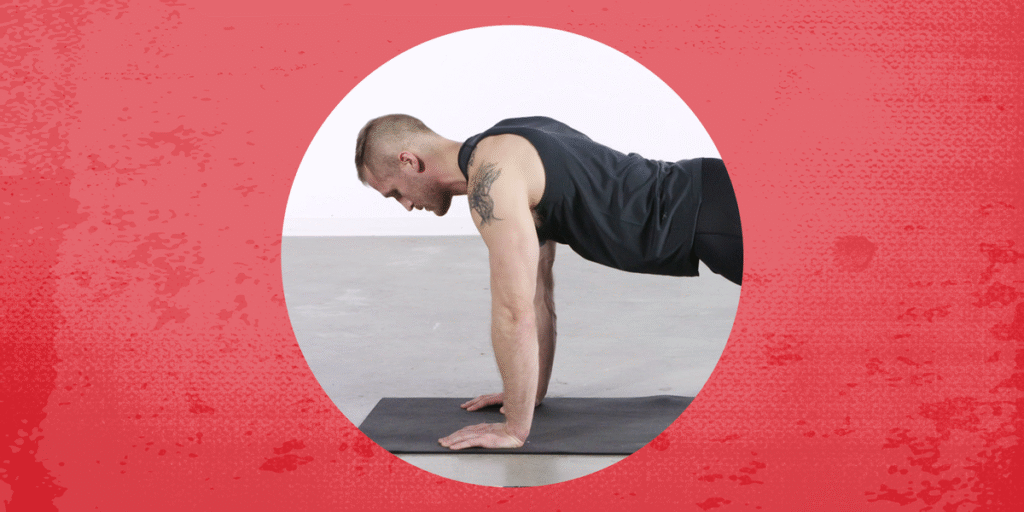THE PUSHUP IS likely one of the first exercises you ever learned, long before you had a dedicated strength training plan or big time goals to build up your body. Whether you first encountered the pushup in gym class or youth sports, the movement is an integral part of a physical education. Little did you know then that the pushup would be a training staple for the rest of your life (and if it’s not, it should be).
As elementary as the pushup can be, the exercise is more technically-demanding than it’s often treated. Proper form is paramount if you want to get the most of the movement, and small mistakes and bad habits can be magnified if you’ve been repeating them for rep after rep, year after year. Pushups are simple, but doing them perfectly isn’t something you can rush.
Even if you consider yourself a pushup pro, take some time to brush up on the proper form before you the move in your training. Let Men’s Health fitness director Ebenezer Samuel, C.S.C.S. and senior editor Brett Williams, NASM-CPT guide you through the exercise’s subtleties, saving you from the bad habits that are keeping you from unlocking your fitness potential.
How to Do the Pushup
Follow these form cues to learn how to do a perfect pushup. Once you’ve read the step-by-step directions, follow along for some higher-level tips from Samuel to dive deeper into the exercise.
- Start in a high plank position, with your palms flat on the floor, stacked directly below your shoulders.
- Squeeze your shoulders, glutes, and core to create full-body tension. Your spine should form a straight line, with a neutral spine.
- Bend your elbows to descend to the floor, stopping with your chest just above the ground. Your elbows should be at a 45 degree angle relative to the torso.
- Press back up off the floor, raising up to the top position with your elbows fully extended.
Own the Plank
Eb says: A pushup isn’t just a chest exercise. It’s a position of full-body tension (or it should be). So start in a good plank: shoulders squeezed, glutes tight, abs tight. Check your form with this video guide to make sure you’re in the proper position.
Squeeze Your Shoulder Blades
Eb says: One of the most common pushup mistakes is trying to hollow out your back. You don’t want to do that. Doing so limits your ability to move your shoulders freely, and it’ll make the pushup a struggle. It can also lead to front shoulder issues, because every time you push up, you’re creating limited space for rotator cuff tendons to move between humerus and clavicle.
Think of squeezing a walnut between your shoulder blades as you lower into the pushup. Pull your torso to the ground, tightening those back muscles, then push up.
Hit the Bench
Eb says: The best regression for pushups isn’t knees on the ground. We see that a lot—and then we see people to struggle to evolve to the full pushup. That’s because you’re not training your glutes and core to properly stabilize.
Instead of doing starting your pushups on your knees, place your hands on a bench and gradually progress to using lower and lower benches (or whatever platform you have handy) for your hands. This will let you work with less load but still train core tension.
Benefits of Pushups
The pushup is an excellent bodyweight exercise that targets the muscles of the upper body and reinforces a strong high plank position. It’s an expression of relative strength, which has more to do with how strong you are compared to your size vs. lifting external weights.
The pushup is extremely versatile. You can do it just about anywhere you have space to stretch out and plant your hands on a stable surface. The pushup is also scaleable; beginners can build their strength up to the point they can do standard reps by elevating their hand position, while advanced trainees can branch out to more challenging variations to target different muscles and progress the movement without adding external resistance.
Which Muscles Pushups Target
The pushup is largely an upper body exercise. Most of the focus goes to the chest (pecs) and shoulders, with your triceps assisting (and, if you move your hands into a narrow position, taking on more of the load).
When you use perfect form, you’ll also engage your core muscles and upper back, as you hold the high plank position and maintain full-body tension.
The Best Pushup Variations
Since the pushup is such a simple movement, a shift in hand placement or body positioning can change the muscle group being targeted or the stimulus. As mentioned above, moving your hands in close together will tax your triceps more greatly, while pressing explosively off the floor will help you hone power. Check out these top variations for more pushup inspiration.
How to Add Pushups to Your Workouts
The pushup is a great bodyweight option on chest day, or just to get up and moving to acclimate your muscles. You can do pushups every day as part of your general workout plan—up to 20 to 25 consecutively on the daily, if you can work your way up to it—as long as you’re balancing out that pressing with some dedicated back movements, too. Add the pushup to your workouts with 3 to 4 sets of 12 to 15 reps. Just make sure that you use solid form, and don’t cheat reps.
Want a more focused pushup endeavor to start a new habit and work up to 50 reps in one set? Try our 30-Day Pushup Challenge, which offers a progressive plan for a full month of training.
Brett Williams, NASM-CPT, PES, a senior editor at Men’s Health, is a certified trainer and former pro football player and tech reporter. You can find his work elsewhere at Mashable, Thrillist, and other outlets.
Read the full article here


